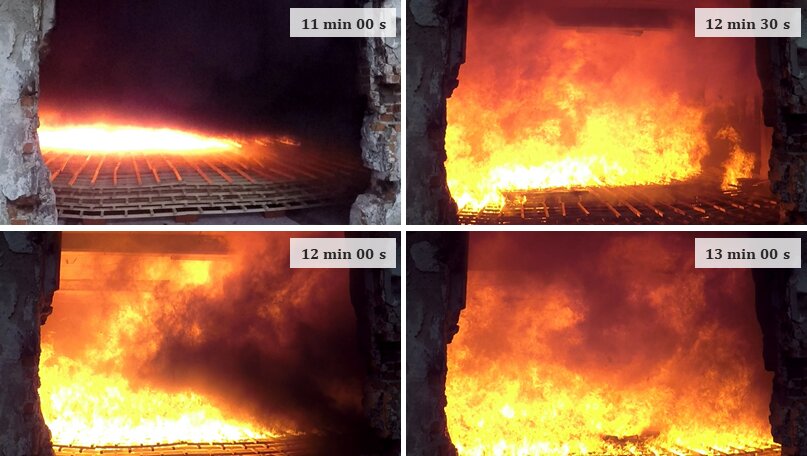
Traveling fires pose an underestimated risk to open building spaces

With more and more large office spaces designed as open-plan, the researchers say their findings should be taken into particular consideration when designing spaces like offices and warehouses larger than 100 m2.
The lesser-known “traveling fires,” which travel within large building compartments rather than engulfing whole rooms at once, can cause at least as much structural damage and potential building collapse as typical fires. They are likely to be especially prevalent in large spaces with ample fuel and fewer doors and interior walls, like open-plan offices and warehouses.
Structural engineers design buildings to survive fires use guidelines like standard fire and Eurocode parametric fires. Using these guidelines, they typically focus on the fires that engulf whole rooms at once, known as flashover fires.
This new research, published today in the journal Fire Technology, shows that open spaces are also vulnerable to traveling fires—a lesser-known fire type that burns locally and moves across an entire floor over time.
Senior author of the paper Professor Guillermo Rein of Imperial’s Department of Mechanical Engineering said: “Previous fire experiments have found that designing against flashover fires is key for buildings with smaller spaces separated by walls and doors. However, now that structural engineers are designing large open-plan spaces more frequently, it’s important to better understand how fires behave in these spaces.
“We found that buildings with open plans are in fact vulnerable to traveling fires, but this fire type is not yet weighted as heavily as flashover fires when designing buildings. We want engineers to understand that protecting against traveling fires could be just as important as protecting against more typical ones. By considering both fire types, engineers can be confident that they are considering the worst-case scenario.”
Traveling fires
Traditional engineering guidelines for assessing fire safety in new buildings are based on observational experiments of fire dynamics in compartments much smaller than 100 m2. These experiments have led to the assumption that flashover fires should be the main objective in structural design against fire. However, due to the lack of experiments in larger compartments, the potential significance of traveling fires in larger compartments is poorly understood.
To put traveling fires to the test, Imperial researchers designed the largest compartment fire experiment ever conducted, known as x-ONE. Using a disused 380 m2 open-space concrete farm building in Poland, they started a fire at one end and measured its behavior as it spread across the 35.5-meter-long compartment. Before doing so, they applied fire protection to columns to prevent structural damage and laid down a bed of fuel to feed the fires.
Within 12 minutes, the fire had spread the length of the compartment and had increased in speed from 0.33 to 16.7 centimeters per second as the size of the fire increased. It burned out after 25 minutes. Despite the size increase, the fire did not reach flashover.
The researchers reported that the fire dynamics observed during x-ONE differed greatly from the fire dynamics reported in small-scale compartment fires in previous studies. The findings also challenge flashover fires as the sole worst-case scenario in designing buildings.
They say this highlights the need for further experiments in large compartments to understand open-space fire dynamics and continue improving the safe design of modern buildings.
Dr. Egle Rackauskaite, who led the work while at Imperial’s Department of Mechanical Engineering and is now at Arup, said: “Despite the lack of advanced studies, traveling fires have been observed in real incidents—for example, in the World Trade Centre towers after the 11 September 2001 attacks. However, these fires have rarely been studied on an experimental basis. At the same time, some modern structures have open-plan spaces between four and 50 times larger than the largest compartment fire experiments conducted to date. This highlights a key knowledge gap in fire engineering design which must be addressed with further research.”
Egle Rackauskaite et al, Fire Experiment Inside a Very Large and Open-Plan Compartment: x-ONE, Fire Technology (2021). DOI: 10.1007/s10694-021-01162-6
Citation:
Traveling fires pose an underestimated risk to open building spaces (2021, October 4)
retrieved 4 October 2021
from https://techxplore.com/news/2021-10-pose-underestimated-spaces.html
This document is subject to copyright. Apart from any fair dealing for the purpose of private study or research, no
part may be reproduced without the written permission. The content is provided for information purposes only.
Stay connected with us on social media platform for instant update click here to join our Twitter, & Facebook
We are now on Telegram. Click here to join our channel (@TechiUpdate) and stay updated with the latest Technology headlines.
For all the latest Technology News Click Here
For the latest news and updates, follow us on Google News.

